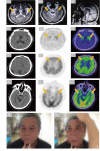FTD-PSP is an Unusual Clinical Phenotype in A Frontotemporal Dementia Patient with A Novel Progranulin Mutation
- PMID: 34631218
- PMCID: PMC8460311
- DOI: 10.14336/AD.2021.0309
FTD-PSP is an Unusual Clinical Phenotype in A Frontotemporal Dementia Patient with A Novel Progranulin Mutation
Abstract
Progranulin (GRN) mutations are a major cause of frontotemporal dementia (FTD); the spectrum of clinical phenotypes of FTD is much more extensive than previously reported. The frequency and locations of GRN mutations in Chinese patients with FTD remain uncertain. We performed cDNA sequencing in one sporadic male patient who initially presented FTD symptoms. Brain magnetic resonance imaging (MRI) and positron emission computed tomography/computed tomography (PET/CT) were applied to further confirm the diagnosis of FTD from this patient. Cellular apoptosis and survival test were performed to identify the function of GRN. We identified one novel missense GRN mutation (c.1498G>A, p.V500I) in this patient, who initially presented typical behavioral-variant frontotemporal dementia (bvFTD) features but then presented progressive supranuclear palsy (PSP) clinical characteristics 5 years after onset. Besides, WT GRN protein showed an adequate trophic stimulus to preserve the survival of SH-SY5Y cells in the medium free of serum, while GRN mutation (c.1498G>A, p.V500I) may impair the ability of supporting cell survival. This study owns significant implications for genetic counseling and clinical heterogeneity. We illustrate the fact that FTD presenting features of bvFTD and PSP in one patient could be considered as a specific phenotype in patients with GRN mutations. GRN p.V500I led to the neuronal degeneration in vitro; this finding provides a significant evidence that this mutation may be a new causative mutation in patients with FTD.
Keywords: Parkinson Syndrome; Progranulin; frontotemporal dementia; mutation; progressive supranuclear palsy.
copyright: © 2021 Deng et al.
Conflict of interest statement
Conflict of interest These authors declare no conflict of interest.
Figures




Similar articles
-
Frontotemporal dementia-related gene mutations in clinical dementia patients from a Chinese population.J Hum Genet. 2016 Dec;61(12):1003-1008. doi: 10.1038/jhg.2016.92. Epub 2016 Jul 21. J Hum Genet. 2016. PMID: 27439681
-
Cerebrospinal Fluid Progranulin, but Not Serum Progranulin, Is Reduced in GRN-Negative Frontotemporal Dementia.Neurodegener Dis. 2017;17(2-3):83-88. doi: 10.1159/000448896. Epub 2016 Oct 20. Neurodegener Dis. 2017. PMID: 27760429
-
Mutations in progranulin (GRN) within the spectrum of clinical and pathological phenotypes of frontotemporal dementia.Lancet Neurol. 2008 Oct;7(10):965-74. doi: 10.1016/S1474-4422(08)70194-7. Epub 2008 Sep 2. Lancet Neurol. 2008. PMID: 18771956 Review.
-
Intrafamilial variable phenotype including corticobasal syndrome in a family with p.P301L mutation in the MAPT gene: first report in South America.Neurobiol Aging. 2017 May;53:195.e11-195.e17. doi: 10.1016/j.neurobiolaging.2017.02.002. Epub 2017 Feb 10. Neurobiol Aging. 2017. PMID: 28268100 Free PMC article.
-
Behavioral variant frontotemporal dementia associated with GRN and ErbB4 gene mutations: a case report and literature review.BMC Med Genomics. 2024 Jan 30;17(1):43. doi: 10.1186/s12920-024-01819-5. BMC Med Genomics. 2024. PMID: 38291418 Free PMC article. Review.
Cited by
-
Frontotemporal Lobar degeneration with TDP-43 presenting as progressive supranuclear palsy syndrome.Acta Neuropathol Commun. 2025 Jul 9;13(1):151. doi: 10.1186/s40478-025-02058-0. Acta Neuropathol Commun. 2025. PMID: 40635087 Free PMC article.
-
Erythrocytes Are an Independent Protective Factor for Vascular Cognitive Impairment in Patients With Severe White Matter Hyperintensities.Front Aging Neurosci. 2022 Feb 18;14:789602. doi: 10.3389/fnagi.2022.789602. eCollection 2022. Front Aging Neurosci. 2022. PMID: 35250538 Free PMC article.
-
Molecular imaging biomarkers in familial frontotemporal lobar degeneration: Progress and prospects.Front Neurol. 2022 Aug 16;13:933217. doi: 10.3389/fneur.2022.933217. eCollection 2022. Front Neurol. 2022. PMID: 36051222 Free PMC article. Review.
-
A novel c.1468 G > A GRN mutation causes frontotemporal dementia in a Chinese Han family.Eur J Med Res. 2025 Mar 8;30(1):157. doi: 10.1186/s40001-025-02418-5. Eur J Med Res. 2025. PMID: 40055834 Free PMC article.
-
Progranulin Gene Mutations in Chinese Patients with Frontotemporal Dementia: A Case Report and Literature Review.J Alzheimers Dis. 2023;93(1):225-234. doi: 10.3233/JAD-230052. J Alzheimers Dis. 2023. PMID: 36970912 Free PMC article. Review.
References
-
- Chang KH, Lee GC, Huang CC, Kuo HC, Chen CM, Hsiao YC, et al.. (2018). Genetic and functional characters of GRN p.T487I mutation in Taiwanese patients with atypical parkinsonian disorders. Parkinsonism Relat Disord, 51:61-66. - PubMed
-
- Chitramuthu B, Bennett H, Bateman A (2017). Progranulin: a new avenue towards the understanding and treatment of neurodegenerative disease. Brain : a journal of neurology, 140:3081-3104. - PubMed
-
- Agarwal S, Ahmed RM, D’Mello M, Foxe D, Kaizik C, Kiernan MC, et al.. (2019). Predictors of survival and progression in behavioural variant frontotemporal dementia. Eur J Neurol, 26:774-779. - PubMed
LinkOut - more resources
Full Text Sources
Miscellaneous
